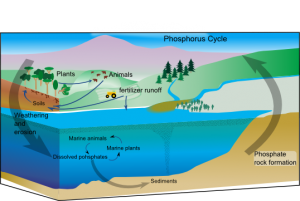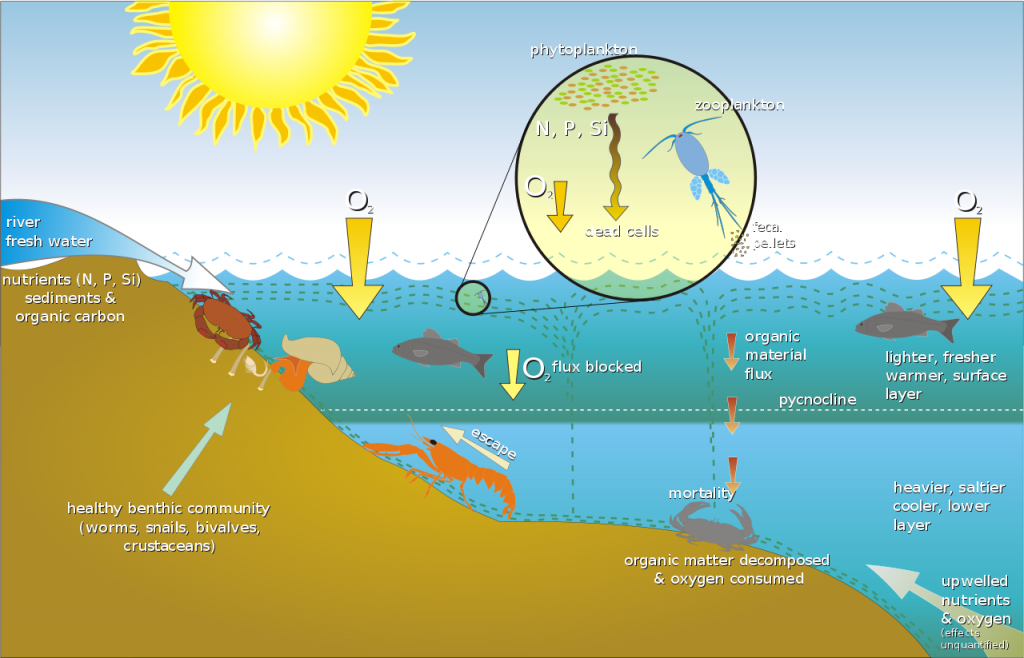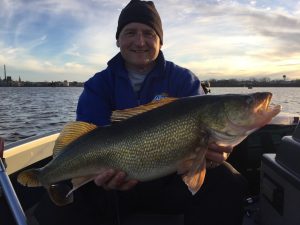Phosphorus: What is it?

Figure 1: Illustrates the phosphorus cycle. Nutrient runoff and soil erosion are two sources of concern.
- Phosphorus is a nutrient that is naturally found at low levels in water, plants, and animals.
- Phosphorus is commonly found unnaturally in fertilizers (used in agriculture and lawn care), cleaners (used in industry), and wastewater (from household and industrial waste).
Total Phosphorus:
- Total Phosphorus (TP), as its name implies, is a measurement that includes all forms of phosphorus (reactive, condensed, and organic).
- TP is the unit of measurement used in the TMDL.
Why should we care about phosphorus in our water?
- Phosphorus in low levels is necessary for life!
- Phosphorus is used to grow healthy crops. It helps provide a strong and resilient root system, which ultimately helps the plant grow. Therefore, producers often add phosphorus to their fields to maintain productive crop yields.
- However, high levels of phosphorus can cause problems in our streams, rivers, lakes, and oceans.
- Because phosphorus helps plants grow on the land, it does the same for aquatic vegetation. High levels of phosphorus results in unhealthy levels of plant growth and specifically, harmful algal blooms.

Image 1: Photo credit, Sam Battle, 1999. Light green on aerial shot indicates an algal bloom on the bay of Green Bay and Lower Fox River
What are harmful algal blooms and why should we care?
While some algae, like green-algae, are an essential component of the food chain and essential to maintaining a healthy ecosystem, there are others, like blue-green algae, that can cause more harm than good. Blue-green algae are generally not eaten by other aquatic organisms; therefore, there is not a natural “check and balance” system to help regulate its growth, which can lead to harmful algal blooms (Image 1). When an algal bloom forms, it creates a “green blanket” of algae that covers the water’s surface and can negatively impact both human health and water quality.
Impacts of algal blooms:
- Dead Zones: The thick blanket of green algae blocks sunlight from penetrating the waters’ surface and reaching underwater plants. Without sunlight, the plants are unable to perform photosynthesis, which produces oxygen; therefore, resulting in hypoxic (low-oxygen) conditions. When algae die, it sinks to the bottom of the river or lake, where it is then decomposed. The breakdown of plant material requires oxygen; therefore, exasperating the already hypoxic conditions. When a large algal bloom dies the decomposition process can consume most or all of the dissolved oxygen; thus, creating a “dead zone,” where most aquatic life either dies or is forced to seek refuge elsewhere (Figure 2).
- Most fish species are capable of seeking refuge outside the dead zone; however, leaving their natural habitat requires them to compete for food and shelter in another area of the river or lake. This can have negative impacts on the rest of the ecosystem.
- Stationary organisms (i.e., plants or benthic life forms) cannot seek oxygen elsewhere and therefore, hypoxic conditions may be fatal.

Figure 2: Graphic credit, Hans Hillewaert. Illustrates the processes that lead up to the creation of a dead zone in a salt water system. Nutrient loading, sediments, and organic carbon are factors that impact dissolved oxygen in both fresh and saltwater systems.
- Economics: According to the Great Lakes Fishery Commission, the Great Lakes fishery is one of the most important freshwater resources on earth and it supports a $7 billion fishing industry. Harmful algal blooms and dead zones pose serious threats to this valuable natural resource.
- The most recent data suggests that Green Bay is a prime destination for anglers (roughly 178,000 in-state and out-of-state anglers per year), contributing more than $114 million in direct retail expenditures and more than $12.5 million in state and local taxes (American Sportfishing Association, 2011). It is suspected that the impact is growing in northeast Wisconsin. To test this theory, the WDNR, University of Wisconsin-Green Bay, University of Wisconsin-Whitewater, and members of Walleyes for Tomorrow have partnered to conduct a more in-depth study.
- Health: Blue-green algae, also known as Cyanobacteria, can produce toxins that can be harmful to human and animal health. For more information about health hazards associated with algal blooms contact, please contact the Wisconsin Department of Health Services.




